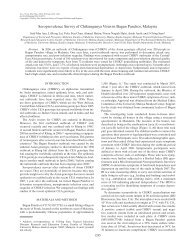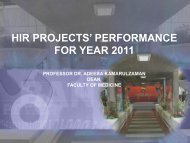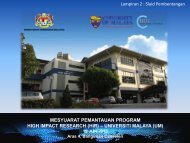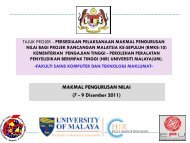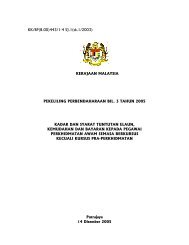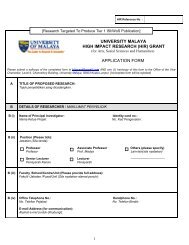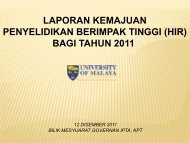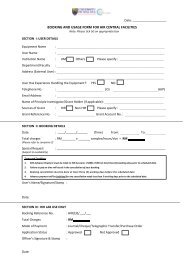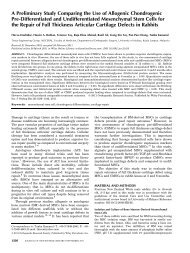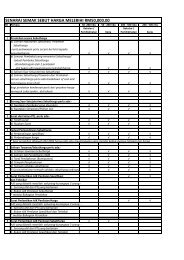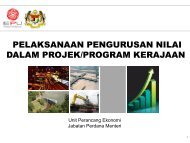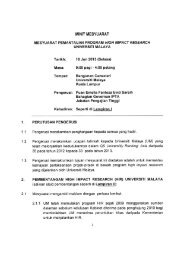Liang Xin Tay, Raja Elina Ahmad, Havva Dashtdar - High Impact ...
Liang Xin Tay, Raja Elina Ahmad, Havva Dashtdar - High Impact ...
Liang Xin Tay, Raja Elina Ahmad, Havva Dashtdar - High Impact ...
Create successful ePaper yourself
Turn your PDF publications into a flip-book with our unique Google optimized e-Paper software.
6 <strong>Tay</strong> et al The American Journal of Sports Medicine<br />
Figure 5. Comparison of the glycosaminoglycan (GAG) concentrations<br />
in the alloMSC and autoC treatment groups with<br />
their respective control groups, showing significant differences<br />
between each treatment with its respective control but<br />
no significant differences between the 2 treatment groups.<br />
alloMSC, allogenic undifferentiated mesenchymal stem cells;<br />
autoC, autologous chondrocytes. *Significant difference<br />
from untreated, negative control (P \ .05).<br />
Glycosaminoglycan Concentrations<br />
in the Regenerated Tissues<br />
Quantitative determination of GAG levels in the tissue samples<br />
revealed a dramatic and significant increase in GAG<br />
concentrations in both the alloMSC- and autoC-treated knees<br />
as compared with the untreated knees (P = .001). However,<br />
there was no significant difference in GAG levels between<br />
the 2 treatment groups (P = .74). The mean GAG/protein concentrations<br />
in the treated knees were 1.7 6 0.3 and 1.8 6<br />
0.5 mg GAGs/mg proteins for the alloMSC and autoC groups,<br />
respectively. For the control knees, the mean GAG/protein<br />
concentrations for the alloMSC and autoC groups were<br />
1.0 6 0.2 and 1.1 6 0.3 mg GAGs/mg proteins, respectively<br />
(Figure 5). No significant differences for both knees were<br />
observed between these groups (P . .05).<br />
DISCUSSION<br />
The use of both autoC and alloMSCs produced comparable<br />
cartilage repair outcome, and was significantly better than<br />
those left untreated. Although the superior outcome of<br />
using cell-based therapy is not unexpected, it is anticipated<br />
that differences between the use of both cell sources should<br />
have been evident in the study. In particular, alloMSC is<br />
postulated to result in superior tissue repair as compared<br />
with autoC in view of the numerous advantages potentially<br />
conferred by MSCs in cartilage regeneration, as further<br />
discussed in this section. In the current study, the morphologic,<br />
histologic, and biochemical profiles of the regenerated<br />
cartilage tissue using the two cell sources were<br />
compared. This was envisaged to provide more objective<br />
evidence and further insight into the effectiveness of the<br />
repair process following either alloMSC or autoC<br />
treatment. To the best of our knowledge, this study is the<br />
first to report the results of direct parallel comparison<br />
between autoC and alloMSC for repair of focal cartilage<br />
defects in an animal model in vivo.<br />
The complementing results observed from the various<br />
parameters examined in this study support the findings<br />
that cell therapies induce cartilage regeneration after<br />
injury. 13,15,20,22,30,50 Histologic observations revealed several<br />
notable features that may be of interest. In the<br />
alloMSC-treated group, chondrocytes in the histologic sections<br />
appeared to be clustered in groups, while in the<br />
autoC-treated group, cells were in columnar arrangements.<br />
However, the difference in the histologic appearance<br />
between the 2 treatment groups did not appear to affect<br />
the O’Driscoll histologic score. It is unclear whether the different<br />
structural arrangements and orientation of cells<br />
within the repair site result in any significant alterations<br />
in the cartilage biomechanical function. Further studies<br />
investigating potential correlation between the different<br />
histologic structures of the regenerated cartilage and its biomechanical<br />
integrity would be of substantial value.<br />
The outcomes of the present study appear to support the<br />
clinical findings published by Nejadnik et al, 38 who concluded<br />
that transplanted autologous bone marrow–derived MSCs in<br />
patients is as effective as ACT. An apparent limitation noted<br />
in the referred study is that there was an absence of standardization<br />
of variables such as the size and the depth of cartilagedefectsaswellaspatientage.Thesefactorsmight<br />
affect the healing process and therefore could potentially confound<br />
the results of the study. It was previously demonstrated<br />
that increased passages and donor age contributed<br />
toward reducing the rate of MSC differentiation, which is critical<br />
to cartilage healing. 7,9,45,46 Thus, we attempted to overcome<br />
this issue by conducting an animal study in a more<br />
controlled environment, which included ensuring the uniformity<br />
of defect size, homogeneous cartilage tissue, similar animal<br />
age, and using an animal from a smaller genetic pool.<br />
Apart from using animals within a narrow margin of age<br />
group, parallel comparison between the treated and<br />
untreated groups was conducted within the same animal in<br />
the present study. The use of cells embedded in alginates<br />
for transplantation was necessary to ensure that transplantation<br />
could be conducted more conveniently in a standardized<br />
manner. In addition, MSCs maintained in a 3-dimensional<br />
environment such as that provided by the alginate scaffold<br />
promotes chondrogenic differentiation and produces selective<br />
upregulation of cartilage-specific genes. 17,26,52 Previous studies<br />
have also shown that chondrocytes in alginate beads<br />
remain viable up to 8 months in culture and produce cellassociated<br />
matrix similar to hyaline articular cartilage. 21,23-25<br />
The use of MSCs as a treatment approach for articular<br />
cartilage injury should be considered since it is associated<br />
with a greater number of advantages and has comparable<br />
efficacy to that of ACI. One of the established limitations of<br />
ACI is the insufficiency in cell supply. Autologous chondrocyte<br />
implantation is commonly associated with limited<br />
ability of the harvested chondrocytes to proliferate and<br />
undergo differentiation. 35 In contrast, MSCs have a higher<br />
capacity of self-replication and differentiation both in vitro<br />
and in vivo. 44 Mesenchymal stem cells are also versatile



